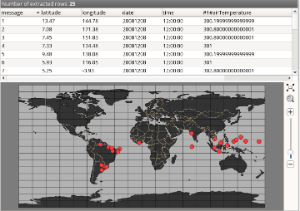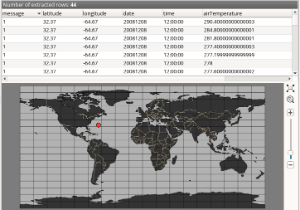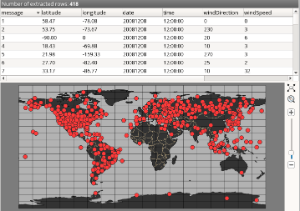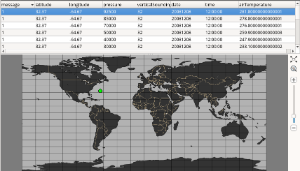...
| Tip |
|---|
These conditions are combined together by the logical AND operator. So a row of data is only added to the results when all the conditions match. |
This is a summary of the data files used for the examples:
| File | Structure | Description |
|---|
| temp.bufr |  Image Modified Image Modified
| Classic radiosonde data. One message contains a vertical profile for one station with various parameters (e.g. temperature, wind etc.) on a set of pressure levels. |
Description| Example | Filter | Results | Comments |
|---|
For all the messages: extract the first non missing temperature value |
| Code Block |
|---|
extract_data: on
parameter_1: airTemperature |
|  Image Modified Image Modified
| By default missing values are ignored in data extraction (see option MISSING DATA) |
| For all the messages: extract the first (rank=1) temperature value (if missing it is ignored) |
| Code Block |
|---|
extract_data: on
parameter_1: airTemperature
parameter_rank_1: 1 |
|  Image Modified Image Modified
| Here we explicitly asked for the first temperature value. It has a missing value in many of the messages so we have less resulting rows that in the previous example. |
| For all the messages: extract the first (rank=1) temperature value if it is greater than 300 K |
| Code Block |
|---|
extract_data: on
parameter_1: airTemperature
parameter_rank_1: 1
parameter_operator_1: >
parameter_value_1: 300 |
|  Image Modified Image Modified
|
|
| For all the messages: extract the first temperature value which is greater than 300 K |
| Code Block |
|---|
extract_data: on
parameter_1: airTemperature
parameter_operator_1: >
parameter_value_1: 300 |
|  Image Modified Image Modified
|
|
For station 78016: extract all the temperature values
|
| Code Block |
|---|
identifier_value: 78016
extract_data: on
parameter_1: airTemperature
extract_mode: all |
|  Image Modified Image Modified
|
...
Description| Example | Filter | Results | Comments |
|---|
For all the messages: extract the first temperature value which is greater than 300 K and also extract the pressure on which it occurs |
| Code Block |
|---|
extract_data: on
parameter_1: airTemperature
parameter_operator_1: >
parameter_value_1: 300
coordinate_condition_count: 1
coordinate_1: pressure |
|  Image Modified Image Modified
| Here we explicitly say the we only want the matching temperature values which appear inside a pressure block (in these messages this is always the case). By using the coordinate condition pressure will be extracted as well because the EXTRACT_COORDINATE option is On by default. |
| For all the messages: extract the first temperature value which is greater than 300 K and the pressure is less than 950 hPa |
| Code Block |
|---|
extract_data: on
parameter_1: airTemperature
parameter_operator_1: >
parameter_value_1: 300
coordinate_condition_count: 1
coordinate_1: pressure
coordinate_operator_1: >
coordinate_value_1: 95000 |
|  Image Modified Image Modified
| Here we further refined the coordinate condition. |
| For all the messages: extract the |
(first) | temperature value on the 500 hPa pressure level |
| Code Block |
|---|
extract_data: on
parameter_1: airTemperature
coordinate_condition_count: 1
coordinate_1: pressure
coordinate_operator_1: =
coordinate_value_1: 50000 |
|  Image Modified Image Modified
|
|
For station 78016: extract the temperature on the second pressure level
|
| Code Block |
|---|
identifier_value: 78016
extract_data: on
parameter_1: airTemperature
coordinate_condition_count: 1
coordinate_1: pressure
coordinate_rank_1: 2 |
|  Image Modified Image Modified
| Here we restricted the filter form one station (message) only and used a rank condition for the coordinate. |
| For station 78016: extract the temperature on the first 6 pressure levels |
| Code Block |
|---|
identifier_value: 78016
extract_data: on
parameter_1: airTemperature
coordinate_condition_count: 1
coordinate_1: pressure
coordinate_rank_1: 1/2/3/4/5/6 |
|  Image Modified Image Modified
| For coordinate rank a list of values can be specified. |
| For station 78016: extract the temperature on the 925, 850 and 700 hPa pressure levels |
| Code Block |
|---|
identifier_value: 78016
extract_data: on
parameter_1: airTemperature
coordinate_condition_count: 1
coordinate_1: pressure
coordinate_operator_1: =
coordinate_value_1: 92500/85000/70000 |
|  Image Modified Image Modified
|
...
Description| Example | Filter | Results | Comments |
|---|
For all the messages: extract the first wind speed and wind direction values |
| Code Block |
|---|
extract_data: on
parameter_1: windDirection
parameter_2: windSpeed |
|  Image Modified Image Modified
|
| Note |
|---|
The order of the parameters in extraction must match their order of appearance in the message. Otherwise the data alignment does not work properly. In our BUFR messages windDirection precedes windSpeed, so we have to use the same ordering. |
|
| For all the messages: extract the first wind speed and wind direction values and also extract their pressure |
| Code Block |
|---|
extract_data: on
parameter_1: windDirection
parameter_2: windSpeed
coordinate_condition_count: 1
coordinate_1: pressure |
|  Image Modified Image Modified
|
|
| For all the messages: extract wind speed and wind direction values on the 500 hPa pressure level |
| Code Block |
|---|
extract_data: on
parameter_1: windDirection
parameter_2: windSpeed
coordinate_condition_count: 1
coordinate_1: pressure
coordinate_operator_1: =
coordinate_value_1: 50000 |
|  Image Modified Image Modified
|
|
Multiple (nested) coordinate conditions
| Task | Filter | Results |
|---|
For station 78016: extract all the temperature values on standard pressure levels |
| Code Block |
|---|
identifier_value: 78016
extract_data: on
parameter_1: airTemperature
coordinate_condition_count: 2
coordinate_1: pressure
coordinate_2: verticalSoundingSignificance
coordinate_operator_2: =
coordinate_value_2: 32 |
|  Image Modified Image Modified
|
| For station 78016: extract all the temperature values on temperature significant levels where the pressure is less than 500 hPa |
| Code Block |
|---|
identifier_value: 78016
extract_data: on
parameter_count: 1
parameter_1: airTemperature
coordinate_condition_count: 2
coordinate_1: pressure
coordinate_operator_1: <
coordinate_value_1: 50000
coordinate_2: verticalSoundingSignificance
coordinate_operator_2: =
coordinate_value_2: 4/68 |
|  Image Modified Image Modified
|
















